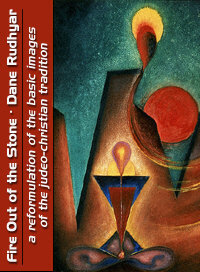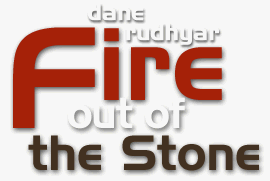 |
| Home | Bio | Art | Music | Literature | Civilization & Culture | Philosophy of Wholeness | Theosophy & Spirituality | Astrology |

FIRE OUT OF THE STONE A Reformulation of the Basic Images of the Judeo-Christian Tradition by Dane Rudhyar, 1962 1. Not to Repeat, But to Renew 2. The Essence and the Substance 3. To Become "More-Than-Man" 4. The Fatherhood of God 5. At the Center is Soul 6. Creation and Evolution 7. Crisis and Sin 8. The Coming-Together of God and Man • Page 1 • Page 2 • Page 3 • Page 4 • Page 5 9. Christ-Love: The Covenant with Individual 10. The Life of Mediation and its Paradox
: : :
This title was first published by Sevire, 1963. Cover for the online edition copyright © 2008 by Michael R. Meyer. : : : : : :
"Thy God is a cosumming fire." Duet. 4:25 "He shall baptize you with the Holy Spirit and with fire." Matthew 3:11 "I am come to send fire on the earth." Luke 12:49
: : :
|

8. THE COMING-TOGETHER OF GOD AND MAN - page 2
"God becomes as we are, so that we may be as He is."
William Blake — There is no Natural Religion; 1788 The Covenant with NoahWe find the terms of the covenant of God with Noah stated in Genesis 9. There we read that God promised He would not again destroy "all flesh" by a repetition of the flood, even though men would still hold evil thoughts — which God apparently realized had now become inevitable (Gen. 8 : 21). The most important fact in this covenant is that God makes the promise to "every living thing" and not only to man. The covenant is made with life itself; it is, we might say, a universal covenant and not merely a God-to-man pact. Life on earth will go on regardless of what man does; and the rainbow, which always has seemed to archaic man to represent a bridge between heaven and earth, is the symbol of this "everlasting covenant between God and every living creature of all flesh that is upon the earth" (Gen. 9 : 16). In future covenants we shall witness God coming ever closer to man in an ever more particularized sense. They will be covenants with a particular race, a particular people or group, and at last — through one individual person. Jesus, with whom He becomes totally united — with every man as an individual. The series of covenants represents, therefore, the progressive stages of the descent of God to man — nay more, the phases of God's "individualization". The Divine becomes progressively involved in the human. This involution of spirit polarizes a symmetrical evolution of the life-principle in man, the "living soul", toward the final stage of "divine soul", of Christhood. As prototypes of characteristic phases of this soul-evolution we have personages such as Noah, Abraham, Moses, David, Solomon and finally Jesus, center of the New Covenant to which the New Testament refers. The archetype-symbol of this dual process of involution-evolution is the 6-pointed star, or Solomon's Seal, revealing the interpenetration of a descending and an ascending triangle. The number 6 is the number of the soul and we find this number stressed in the measurements of the Ark. As a result of the coming-together of God with Noah who has emerged successfully from his crisis and his tests, we see Noah becoming "an husbandman" and planting a "vineyard". Orthodox interpreters and ethnologists take these words literally; but, if one does so, the story immediately following of Noah's drunkenness and of the cursing of "Ham, father of Canaan", because he "saw his father's nakedness", makes very little sense. Esoteric tradition and the well known symbolism of the "drinking of the wine" in all Near-Eastern mysticism tell us, however, that a "vineyard" symbolized a "school of initiation" and the drinking of the wine referred to the partaking of divine inspiration and entering into some kind of mystic state. Thus what the Biblical story tells us in symbols is that as a result of this universalistic coming-together of God and Noah, Noah began to develop a type of spiritual-mystic "culture" by means of which men could soar into the realm of a universal awareness of "life" and communicate with the "God of life", Jehovah — using, as it were, the rainbow as a bridge. Every symbol used as "seal" of a covenant between God and man can be used also by man as a means to reach divine consciousness at the stage indicated by the covenant. The story of Ham seeing the nakedness of his father no doubt refers to an unauthorized and unprepared attempt by a portion of humanity to "storm the gates of heaven" by uncovering and appropriating to itself the secrets of initiation. Here again we see the operation of the dualistic law symbolized by the tree of good and evil. In Eden God gave Adam (Ish) a woman (Isha), establishing the principle of life's polarization — the principle to which Hindu philosophers refer under the names Shiva and Shakti, consciousness and power-of-action. There is no reason to believe that the "eating of the fruit" refers to the consummation of the instinctual, pure, spontaneous sexual act — unless one be a Freudian! This fruit is the expression of the choice of an attitude with regard to procreation and to life in general. One attitude is "good", the other "evil". One brings the relationship of God to man into the natural act; the other ignores such a relationship and makes of sex the expression of merely instinctual desires and organic excitement — and later on perhaps, of intellectual frustration or of a yearning for power and ego-glorification. The dualism of Cain and Abel likewise refers to two basic attitudes toward the sustaining of man's life: Cain taking the humanly positive attitude of "tilling the ground" with sharp tools; Abel taking the receptive attitude of one who watches and encourages the spontaneous product of animal mating. When "the sons of God" come to the earth and marry "the daughters of men" and as a result "mighty men, men of renown" are born, this possibility for a man to become great and famous by the use of creative energies becomes disoriented and destructive — thus negative and evil. Men who have become jealous of the truly great ones attempt to reach an equal stature and fame by the perverted use of power — or by building "systems" and "doctrines" instead of being simply what they are! Finally when Noah is able to "husband" in a definite and reliable manner the higher energies of life leading to mystic consciousness, one of his three sons, Ham, somehow forces himself into the sanctuary and "sees" what it was not lawful for him to perceive. Presumably he spreads that mystic knowledge without demanding from his disciples the necessary qualifications, while the other two sons "cover up" this mystic knowledge so that evil will not take hold of entire communities through unprepared and untested (i.e., un-initiated) men. Evil spreads in the form of man's pride — the tower of Babel made of dried-up "mud" — the pride of a merely human knowledge not really based on the "rock" of divine communication. Men seek to reach knowledge and greatness only by their own efforts, forgetting that this upward effort of the human mind should be polarized by a descent of the divine if it is to be spiritually valid and illumined by "Truth". A further form of evil develops in Sodom and Gomorrah. The Vineyard of Noah, the illumined agent of God, degenerates into the "vine of Sodom" whose fruits are bitter and disintegrate into dust (Deut. 32 : 32). The two cities are destroyed but in the meantime Abram, a descendant of Shem, son of Noah, flourishes, being "rich in cattle, in silver and in gold". We see man now having reached a fully developed tribal state, though largely, insofar as Abram and Lot are concerned, through the pastoral life as opposed to that of the "wicked cities of the plain." Then God once more establishes His covenant with the pure line of human soul-evolution — i.e., with Abram.  Home | About | Calendar | Ephemeris Charts | Art Gallery | Library | Resources Shop | Rudhyar Archival Project | Help Web design and all data, text and graphics appearing on this site are protected by US and International Copyright and are not to be reproduced, distributed, circulated, offered for sale, or given away, in any form, by any means, electronic or conventional. See Notices for full copyright statement and conditions of use. Web design copyright © 2000-2004 by Michael R. Meyer. All Rights Reserved. |